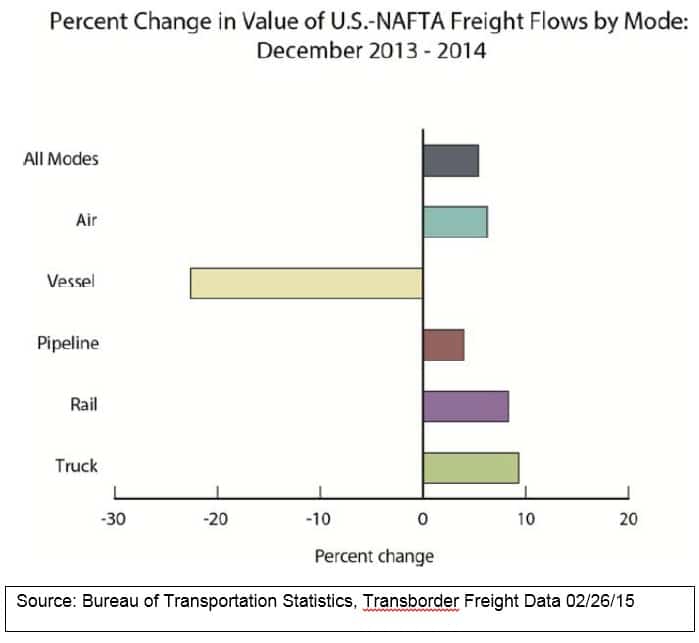Bureau of Transportation Statistics
U.S.-NAFTA freight totaled $95.8 billion in December 2014 as four out of five transportation modes – truck, rail, air, and pipeline – carried more U.S.-NAFTA freight than in December 2013, according to data released today by the U.S. Department of Transportation’s Bureau of Transportation Statistics (BTS) (Table 1). Year-over-year, the value of U.S.-NAFTA freight flows by all modes increased by 5.4 percent, with December marking the 11th consecutive month of year-over-year increases.
 The value of NAFTA trade by vessel declined in December due to the reduced price of mineral fuels. The rise in total pipeline freight value took place despite a decline in cost per unit, due to an increase in the volume of freight.
The value of NAFTA trade by vessel declined in December due to the reduced price of mineral fuels. The rise in total pipeline freight value took place despite a decline in cost per unit, due to an increase in the volume of freight.
Freight by Mode
In December 2014 compared to December 2013, the value of commodities moving by truck grew by the largest percentage of any mode, 9.3 percent. Rail freight increased by 8.3 percent, air rose by 6.3 percent, and pipeline grew by 4.0 percent. Vessel freight decreased by 22.6 percent, mainly due to lower mineral fuel prices.
Trucks carried 59.2 percent of U.S.-NAFTA freight and were the most heavily utilized mode for moving goods to and from both U.S.-NAFTA partners. Trucks accounted for $28.4 billion of the $52.5 billion of imports (54.0 percent) and $28.4 billion of the $43.3 billion of exports (65.6 percent).
Rail remained the second largest mode, moving 15.1 percent of all U.S.-NAFTA freight, followed by vessel, 8.3 percent; pipeline, 8.0 percent; and air, 4.1 percent. The surface transportation modes of truck, rail and pipeline carried 82.3 percent of the total U.S.-NAFTA freight flows.
>> Click here to access the entire press release from the Bureau of Transportation Statistics.
